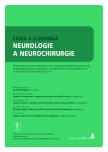Regulation of mRNA expression of the SMN2 gene by histone deacetylase inhibitors and their influence on the phenotype of type I and II spinal muscular atrophy
Authors:
P. Vondráček 1; E. Zapletalová 2; H. Ošlejšková 1; L. Mlčáková 3; L. Fajkusová 2
Authors‘ workplace:
Klinika dětské neurologie LF MU a FN Brno
1; Centrum molekulární biologie a genové terapie PřF MU a FN Brno
2; Neurologická klinika LF MU a FN Brno
3
Published in:
Cesk Slov Neurol N 2007; 70/103(4): 413-418
Category:
Short Communication
Podpořeno granty IGA MZ ČR číslo 1A/8608-4 a MSM0021622415.
Overview
Spinal muscular atrophy (SMA) type I and II (Werdnig-Hoffmann disease) is a serious autosomal recessive neuromuscular disease in children. The SMA causing gene – survival motor neuron gene (SMN) is duplicated, with telomeric copy (SMN1) and centromeric copy (SMN2). Histone deacetylase inhibitors phenylbutyrate (PBA) and valproic acid (VPA) can modify the pattern of SMN2 splicing in SMA patients towards increase of full-length SMN2 mRNA and amount of the SMN protein. The aim of our study was to correlate SMN2 gene copy numbers and changes in expression of full length mRNA with clinical outcomes in small groups of SMA type I and II patients treated with PBA (N = 6) or VPA (N = 11). The Hammersmith functional motor scale was evaluated at baseline and after 8 weeks of medication. 2 patients out of 4 in the PBA group and 5 patients out of 11 in the VPA group showed an increase of 3 or 4 points in the Hammersmith scale. 4 patients showed the increase of 4 points in the Hammersmith scale but only 2 had significantly increased levels of full-length SMN2 mRNA. The results obtained during therapy justify future interventional trials with histone deacetylase inhibitors.
Key words:
spinal muscular atrophy – SMN (survival motor neuron) gene – histone deacetylase inhibitors – phenylbutyrate – valproic acid – Hammersmith scale
Sources
1. Kraus J, Hedvičáková P. Spinální svalové atrofie v dětském věku. Neurol pro praxi 2006; 1: 18-19.
2. Pleasure D. New treatments for denervating diseases. J Child Neurol 2005; 3: 258-262.
3. Andreassi C, Angelozzi C, Tiziano FD, Vitali T, De Vincenzi E, Boninsegna A et al. Phenylbutyrate increases SMN expression in vitro: relevance for treatment of spinal muscular atrophy. Eur J Hum Genet 2004; 1: 59-65.
4. Brahe C, Vitali T, Tiziano FD, Angelozzi C, Pinto AM, Borgo F et al. Phenylbutyrate increases SMN gene expression in spinal muscular atrophy patients. Eur J Hum Genet 2005; 2: 256-259.
5. Maestri NE, Brusilow SW, Clissold DB, Bassett SS. Long-term treatment of girls with ornithine transcarbamylase deficiency. N Engl J Med 1996; 12: 855-859.
6. Mercuri E, Bertini E, Messina S, Pelliccioni M, D´Amico A, Colitto F et al. Pilot trial of phenylbutyrate in spinal muscular atrophy. Neuromuscul Disord 2004; 14: 130-135.
7. Mercuri E, Bertini E, Messina S, Solari A, D'Amico A, Angelozzi C et al. Randomized, double-blind, placebo-controlled trial of phenylbutyrate in spinal muscular atrophy. Neurology 2007; 1: 51-55.
8. Mercuri E, Messina S, Battini R, Berardinelli A, Boffi P, Bono R et al. Reliability of the Hammersmith functional motor scale for spinal muscular atrophy in a multicentric study. Neuromuscul Disord 2006; 2: 93-98.
9. Krosschell KJ, Maczulski JA, Crawford TO, Scott C, Swoboda KJ. A modified Hammersmith functional motor scale for use in multi-center research on spinal muscular atrophy. Neuromuscul Disord 2006; 7: 417-426.
10. Brichta L, Hofmann Y, Hahnen E, Siebzehnrubl FA, Raschke H, Blumcke I et al. Valproic acid increases the SMN2 protein level: a well-known drug as a potential therapy for spinal muscular atrophy. Hum Mol Genet 2003; 19: 2481-2489.
11. Weihl CC, Connolly AM, Pestronk A. Valproate may improve strength and function in patients with type III/IV spinal muscle atrophy. Neurology 2006; 3: 500-501.
12. http://www.curesma.org
13. Pfaffl MW. A new mathematical model for relative quantification in real-time RT-PCR. Nucleic Acids Res 2001; 9: e45.
14. Livak KJ, Schmittgen TD. Analysis of relative gene expression data using real-time quantitative PCR and the 2(-Delta Delta C(T)) Method.
Methods 2001; 4: 402-408.
15. Wirth B, Brichta L, Hahnen E. Spinal muscular atrophy: from gene to therapy. Semin Pediatr Neurol 2006; 2: 121-131.
16. Wirth B, Brichta L, Hahnen E. Spinal muscular atrophy and therapeutic prospects.
Prog Mol Subcell Biol 2006; 44: 109-132.
17. Riessland M, Brichta L, Hahnen E, Wirth B. The benzamide M344, a novel histone deacetylase inhibitor, significantly increases SMN2 RNA/protein levels in spinal muscular atrophy cells. Hum Genet 2006; 1: 101-110.
18. Hahnen E, Eyupoglu IY, Brichta L, Haastert K, Trankle C, Siebzehnrubl FA et.al. In vitro and ex vivo evaluation of second-generation histone deacetylase inhibitors for the treatment of spinal muscular atrophy. J Neurochem 2006; 1: 193-202.
19. Vondracek P, Fajkusova L, Hermanova M, Balintova Z, Seeman P, Mazanec R et al. New Perspectives in the Treatment of Inherited Neuromuscular Disorders: Innovative Ideas for Third Millenium. In: Engels JV (Eds). Focus on Birth Defects Research. New York: Nova Science Publishers 2006: 161-183.
20. www.enmc.org
Labels
Paediatric neurology Neurosurgery NeurologyArticle was published in
Czech and Slovak Neurology and Neurosurgery

2007 Issue 4
- Metamizole vs. Tramadol in Postoperative Analgesia
- Metamizole at a Glance and in Practice – Effective Non-Opioid Analgesic for All Ages
- Memantine in Dementia Therapy – Current Findings and Possible Future Applications
- Memantine Eases Daily Life for Patients and Caregivers
- Advances in the Treatment of Myasthenia Gravis on the Horizon
Most read in this issue
- Cervical dystonia
- Levels of D-dimers in patients with acute ischaemic stroke
- Thrombosis of the sigmoid sinus – current views on diagnosing and treatment
- Repetitive transcranial magnetic stimulation and chronic subjective tinnitus
